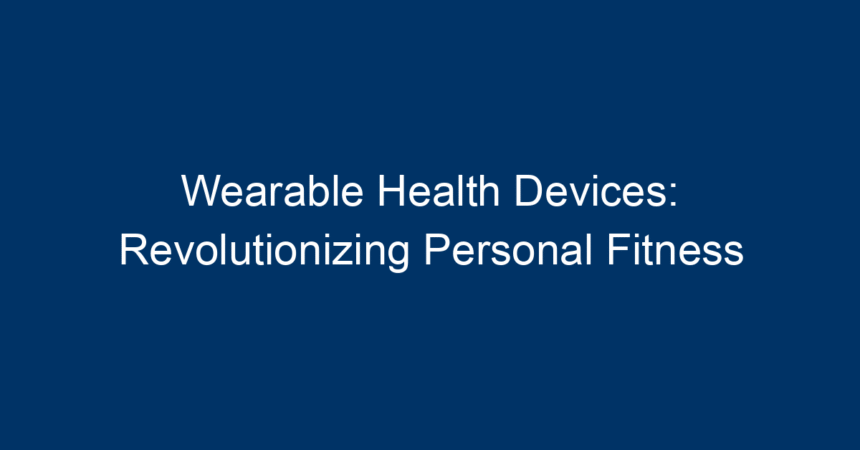In today’s fast-paced world, maintaining personal fitness has become more critical than ever. With rising health concerns, from obesity to chronic diseases, individuals are seeking more innovative ways to monitor and improve their health. Enter wearable health devices: compact technology that we can use directly on our bodies to track fitness and wellness metrics in real-time. This article delves into the evolution, types, benefits, and future of wearable health devices, providing you with actionable insights to enhance your fitness journey.
The Evolution of Wearable Health Devices
A Brief History
The journey of wearable health devices began in the early 1980s with simple pedometers. These devices ignited people’s interest in tracking daily physical activity. Fast-forward to the 2010s, we witnessed the launch of more sophisticated devices such as smartwatches and fitness trackers. Brands like Fitbit, Apple, and Garmin have popularized these gadgets, offering a wide array of health-monitoring capabilities.
From Basic to Advanced
Old-school pedometers counted steps, but modern wearable health devices can do so much more. Today’s devices not only track steps but also monitor heart rate, sleep patterns, calories burned, and even stress levels. With advancements in technology, they have become indispensable tools for personal fitness and health management.
Types of Wearable Health Devices
1. Fitness Trackers
Fitness trackers are among the most popular types of wearable health devices. Offering features like step counting, sleep tracking, and exercise recognition, these gadgets provide valuable insights into daily activity levels. Popular models include the Fitbit Charge and Garmin Vivosmart.
2. Smartwatches
Smartwatches, like the Apple Watch and Samsung Galaxy Watch, blend clock functionalities with fitness tracking. They enable users to receive notifications, make calls, and even monitor advanced health metrics such as blood oxygen levels and ECG readings.
3. Heart Rate Monitors
Heart rate monitors can be standalone devices or integrated into fitness trackers and smartwatches. They are essential for those engaging in high-intensity workouts, allowing for precise cardio monitoring. Chest strap monitors are popular among athletes for their accuracy.
4. Sleep Trackers
Sleep trackers, often integrated within fitness bands or smartwatches, analyze sleep patterns. They provide insights into sleep quality, duration, and disturbances. This data can help users improve their sleep hygiene for better overall health.
5. Specialized Health Monitors
Certain devices focus on specific health metrics. For example, glucose monitors help diabetics track blood sugar, while wearable ECG monitors can alert users to irregular heartbeats. These devices have raised the bar for health management, giving individuals more control over their well-being.
Benefits of Wearable Health Devices
1. Real-Time Data Tracking
One of the most significant advantages of wearable health devices is their ability to provide real-time data. Knowing how many calories you’ve burned or your current heart rate can help users make informed choices during workouts.
2. Enhanced Motivation
Tracking progress visually can be incredibly motivating. Wearable health devices often feature leaderboards, badges, and challenges, encouraging users to stay active and achieve personal bests.
3. Personalized Health Insights
These devices collect vast amounts of data, allowing for personalized recommendations. Users can identify patterns and make changes tailored to their fitness goals, whether aiming to lose weight or improve endurance.
4. Better Health Management
Individuals with chronic health issues can benefit immensely from wearable health devices. Continuous monitoring provides actionable insights, aiding in the management of conditions such as hypertension and diabetes.
5. Connectivity and Community
Many wearable health devices offer social features that enable sharing progress within a community. This connectivity fosters accountability and creates a supportive network, enhancing the fitness experience.
Challenges and Considerations
While wearable health devices offer substantial advantages, they are not without challenges.
1. Data Privacy
With great data comes great responsibility. Users must ensure they’re using devices from reputable manufacturers that comply with privacy standards. Be mindful of data sharing settings and consent agreements when using fitness apps.
2. Accuracy
The accuracy of wearable health devices can vary. Some devices may overestimate or underestimate metrics like calorie burn or heart rate. It’s essential to calibrate your device and cross-check with traditional methods as needed.
3. Battery Life and Maintenance
Many wearable devices require regular charging, and their lifespan can be limited due to wear and tear. Users should consider battery life and maintenance requirements when selecting a device.
Future Trends in Wearable Health Devices
The future of wearable health devices looks promising, with several trends emerging:
1. Advanced Health Metrics
Expect advancements in metrics such as hydration levels, body temperature, and even mood tracking. As technology evolves, the comprehensiveness of health data will likely increase.
2. Integration with Telehealth
Wearable health devices can provide real-time data to healthcare providers, enabling more proactive health management. This integration could lead to improved patient outcomes through timely interventions.
3. AI and Machine Learning
Future devices may incorporate AI and machine learning technologies to provide personalized fitness and health advice by analyzing user data more effectively and suggesting customized workout plans.
4. Fashion Meets Functionality
As the market grows, design and aesthetics will also become a focal point. Expect to see wearable health devices that cater not only to functionality but also style and personal expression.
Conclusion: Take Action with Wearable Health Devices
In conclusion, wearable health devices are revolutionizing personal fitness by providing real-time data, enhancing motivation, and aiding in health management. To make the most out of these devices:
- Choose Wisely: Select a device that fits your lifestyle and health needs. Consider what metrics are most important to you.
- Set Realistic Goals: Use the data to set achievable fitness goals that encourage consistent progress.
- Stay Engaged: Use social features to connect with others for motivation and accountability.
- Stay Informed: Keep up with advancements in technology and metrics that can further improve your fitness journey.
As you embrace the future of fitness technology, the most important factor remains you: your commitment to improving your health and wellness.
Harness the power of wearable health devices and take charge of your fitness journey today!




